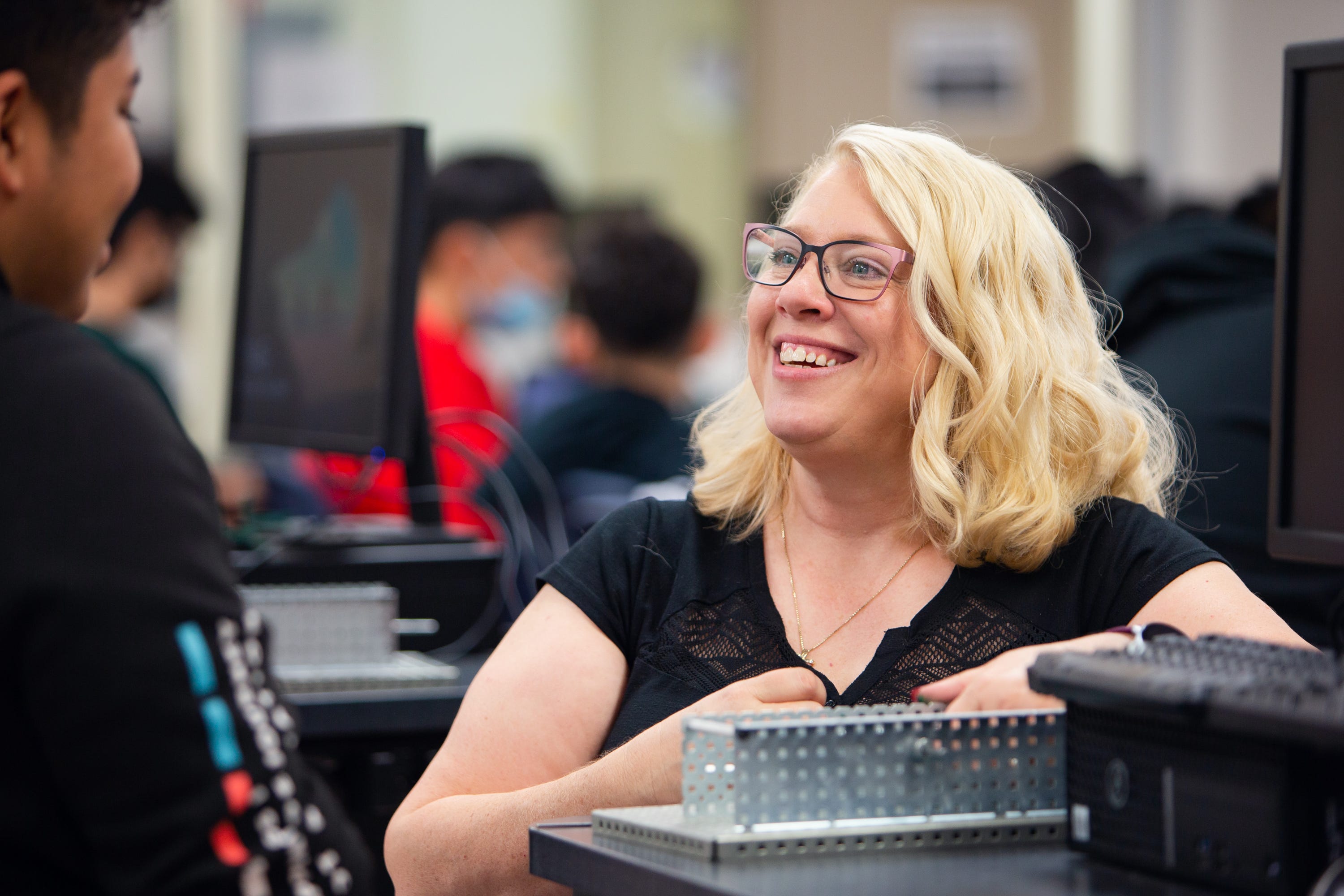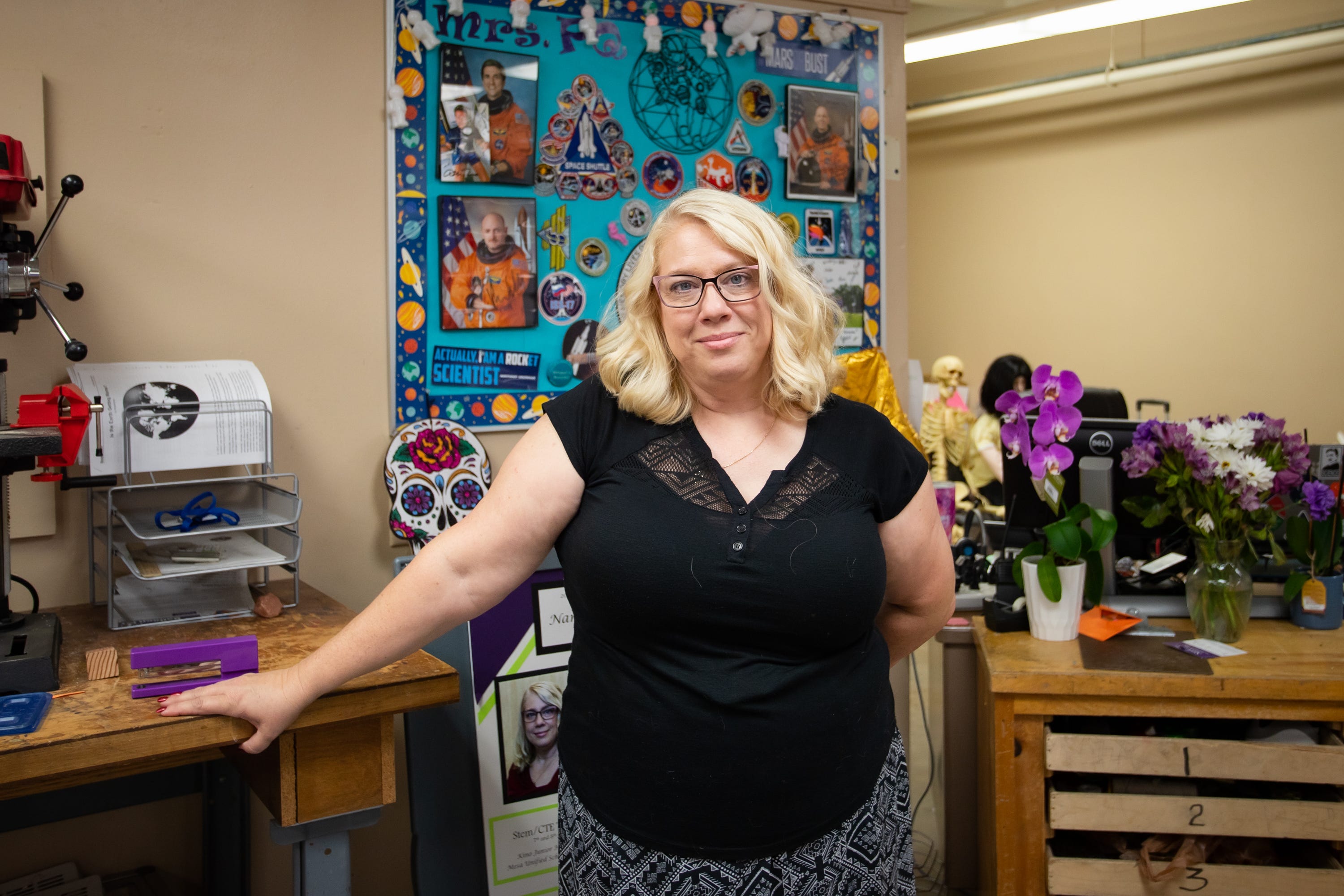
Megan Mendoza/The Republic
When junior high teacher Nancy Parra-Quinlan plans lessons for her students, she’s not just looking for them to hit content knowledge benchmarks. She’s also looking for the twinkle, the spark, the glimmer that shows they’ve not only understood a topic, but are excited by it.
For her flight and space class where students build and launch rockets, that’s the moment they take off.
“Just watching their faces, the excitement — your eyes are glued to it,” Parra-Quinlan said.
Parra-Quinlan teaches objectively interesting subjects: engineering, robotics, flight and space and even a medical detectives course. But that isn’t what makes Parra-Quinlan, who was named the 2022 Arizona Teacher of the Year this fall, an excellent educator.
From creating captivating lessons to building real and lasting relationships with the students at Kino Junior High School in Mesa Public Schools as both a teacher and club mentor, Parra-Quinlan’s approach to teaching is part of a long-term effort to help more women and students of color enter the STEM field.
She’s also an industry volunteer. Parra-Quinlan volunteers with the Civil Air Patrol as the statewide Assistant Director of Aerospace Education and with the 305th Squadron at Falcon Field in Mesa as the Aerospace Education Officer.
For her students, that has been a consistent space of admiration.
“She is smart and she does a lot more than what most men can do,” Jaya Myers, her 7th-grade student, said. “She is a really powerful image of what women can be.”
Amid the pandemic, a novel approach to reaching remote students
For Parra-Quinlan, connecting with her students through hands-on activities has always been one of the most important parts of her teaching practice.
“They’re up, they’re talking, they’re moving, they’re building, they’re interacting,” Parra-Quinlan said of her typical classroom environment.
That means when a student isn’t involved, it can be easy to see. “If I see them sitting, I tell them, ‘Hey, you’re not doing what you’re supposed to do. Go work with your partner, go work with your team.’”
But when COVID-19 closed down schools, and working-class families of color were particularly impacted, she faced a new set of challenges as an educator.
At Kino Junior High School, a Title 1 school with a high concentration of low-income students and where 75% of the student body is Latino, according to the Arizona School Report Card, many of Parra-Quinlan’s students chose remote learning last year.
That made the hands-on part of learning robotics and science particularly difficult.
But Parra-Quinlan didn’t let that stop her. When it was time for her students to learn how to dissect a sheep’s brain, she drove around to the houses of remote students and dropped off a brain for each of them.
“We sort of did like a ding-dong ditch. We would leave it at the front door, ring the doorbell and then stand way back,” she said. “It was great, that they actually got to participate.”
“If I can give them that, when it’s been such a rough year and a half, if I can just give them a little bit of hands-on exploration, that’s gonna make them feel a lot better.”
Two of Parra-Quinlan’s students, one current and one former, speak highly of her teaching approach, which they say challenges and supports them in equal measure.
Myers, a 7th-grade student at Kino, calls her teacher a no-nonsense educator who works hard to make sure students are paying attention and also that they feel cared for.
“The kids that don’t listen or pay attention – she will make them pay attention,” Myers said. “It makes it an easier learning environment without all of those distractions.”
Hannah Pehl, who had Parra-Quinlan as a middle school teacher and robotics club mentor, said she wouldn’t be studying mechanical engineering at university without her support.
“She is a great and amazing person. She really cares for everybody,” Pehl said, whose younger sister was also in the robotics club at Kino. “If somebody is behind she will work and help them, but if you are ahead, she will also give you extra stuff to do so you can learn deeper.”
Advice from 28 years as an educator

Megan Mendoza/The Republic
Arizona has a high teacher turnover rate and a chronic shortage of educators. Add to that the difficulty of the pandemic years for teachers, many of whom had to first learn to teach remotely, then return to classes as the virus has raged and are now under pressure to fill student learning gaps.
That’s one of the reasons that Parra-Quinlan says she is determined to use her time as Arizona Teacher of the Year, which offers a chance to travel and a new platform, to remind people about the difficult work of being an educator.
“I want to acknowledge all those teachers who take work home with them to grade, who spend nights and weekends making lesson plans, who buy things for students out of their own pockets,” Parra-Quinlan said as she accepted her award at the 2022 Arizona Teacher of the Year ceremony. “You all deserve recognition.”
As a 28-year veteran educator, Parra-Quinlan suggests teachers find a community that understands the difficulty of their work, and can support them through it.
“Find the teachers at your school, or find other people that you know that are teachers, and surround yourself with people that you can talk to, people you can vent to, people you can share your ideas with,” she said. For herself, she also kayaks as a form of stress relief.
Still, Parra-Quinlan wants to remind everyone that there is a teacher in their life that they can thank.
“We all have a teacher that meant something to us,” she said. “Teachers don’t get a lot of recognition for what they’re doing. So I’d like to ask you, if — when you have some time, think of a teacher that made a difference to you, and do what you can to try and either reach out to them with an email or a letter or a phone call or something to thank them for, you know, making an impression on you.”
Reach the reporter at ykunichoff@arizonarepublic.com and follow her on Twitter @yanazure.
Support local journalism. Subscribe to azcentral.com today.
Credit: Source link



















